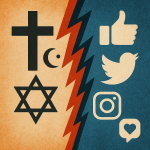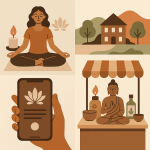Digital Divides in Faith: Urban vs Rural, Connected vs Not-Connected in India
In the 21st century, faith has gone digital. Online darshans, livestreamed aartis, virtual congregations, and religious apps have redefined how Indians connect with spirituality. The COVID-19 pandemic accelerated this transformation, turning temples, mosques, churches, and gurudwaras into digital hubs of devotion. Yet, behind this new age of connected spirituality lies a profound divide — between those who can access faith online and those who cannot. In India, where internet access and digital literacy vary sharply across regions, a new spiritual inequality is emerging: the digital divide in faith.
The Rise of Digital Religion
India’s religious institutions were quick to adapt to digital technologies. Temples began streaming rituals on YouTube, priests offered online pujas, and devotees booked sevas through mobile apps. The Tirumala Tirupati Devasthanams launched digital platforms for offerings, while Delhi’s Jama Masjid broadcast Friday prayers for followers across the world. For many urban devotees, digital faith has become both convenient and accessible — an extension of their daily spiritual practice.
Social media, too, has become a powerful tool for religious expression. From live kirtans on Facebook to WhatsApp groups for prayer circles, digital faith communities are thriving. Religious influencers and preachers have millions of followers on Instagram and YouTube, shaping modern discourse around devotion, ethics, and morality. In many ways, the internet has democratized religious communication, breaking hierarchies and making spiritual content available at a click.
The Rural Disconnect
But this digital revolution is far from universal. In rural India, where internet penetration and smartphone access remain limited, the experience of faith remains largely traditional and offline. Temples and shrines in villages may not have the resources or technical know-how to livestream rituals or build websites. For many devotees, religion continues to be a community-based, physical experience — attending local festivals, visiting nearby temples, and listening to oral storytelling from priests or elders.
This contrast is not just about technology; it is about participation and visibility. Urban believers increasingly shape online religious narratives, while rural voices remain unheard in the digital space. The teachings, chants, or rituals unique to small communities often go undocumented, leading to a slow cultural invisibility. When faith goes online, those without digital access risk being left out of the new spiritual mainstream.
Faith and Digital Inequality
The digital divide in faith mirrors India’s broader social inequalities — of education, gender, and geography. Men are more likely to use smartphones for religious content, while many rural women, especially the elderly, still rely on radio or community gatherings. Regions with poor connectivity — the Northeast, parts of central India, and tribal areas — are cut off from the growing ecosystem of online religious education, apps, and donation platforms.
This divide also affects religious institutions. Wealthier temples and churches can afford digital infrastructure, while smaller shrines depend entirely on physical offerings. As donations shift online, some local religious economies suffer, deepening economic inequality between urban and rural religious centers. Faith, which once united people through common rituals, is now being segmented by access to technology.
Virtual vs. Physical Spirituality
The digital turn has also transformed the very experience of worship. For urban devotees, watching an aarti on a smartphone may be comforting, but it cannot replicate the sensory experience of sound, smell, and community presence at a temple. The sense of darshan — the sacred gaze exchanged between devotee and deity — loses some of its intimacy through a screen.
Rural faith practices, on the other hand, retain this embodied spirituality. The rhythm of collective rituals, processions, and seasonal festivals continues to bind communities together. Yet, the lack of digital documentation means these practices remain underrepresented in national or global narratives. The divide, therefore, is not only technological but also emotional and cultural — between mediated devotion and lived experience.
Bridging the Digital Faith Gap
Closing this digital divide requires more than improving internet access; it demands inclusivity in design and intention. Faith-based organizations can play a pivotal role by ensuring that digital initiatives reach grassroots communities. Simple mobile-friendly platforms in regional languages, low-data livestreams, and digital training for priests or volunteers can help rural temples and mosques connect with larger audiences.
The government’s Digital India initiative can collaborate with religious institutions to preserve and share heritage content — from folk songs and local rituals to temple architecture. NGOs and community groups can help record oral traditions and archive them online, giving digital presence to those whose faith has long been offline. Such efforts would not only bridge technological gaps but also ensure cultural continuity.
A New Kind of Spiritual Inequality
The digital divide in faith is a reminder that technology, while powerful, can both connect and exclude. Urban believers enjoy a globalized, multimedia form of spirituality, while many rural Indians continue to live their faith in analog ways. Both forms are valid — one is virtual, the other visceral — but without equitable access, the digital transformation of religion risks deepening social disparities.
If technology is to serve spirituality, it must do so ethically — by empowering the unconnected, not overshadowing them. The goal should not be to replace physical devotion with digital convenience, but to create bridges between them.
India’s spiritual strength has always lain in its diversity — in the coexistence of the sacred river and the smartphone, the village shrine and the digital temple. The challenge now is to ensure that this coexistence remains inclusive. For in the end, true connection in faith lies not in Wi-Fi signals or livestream links, but in the shared human longing for meaning — a connection that transcends both geography and technology.
~Religion World Bureau









